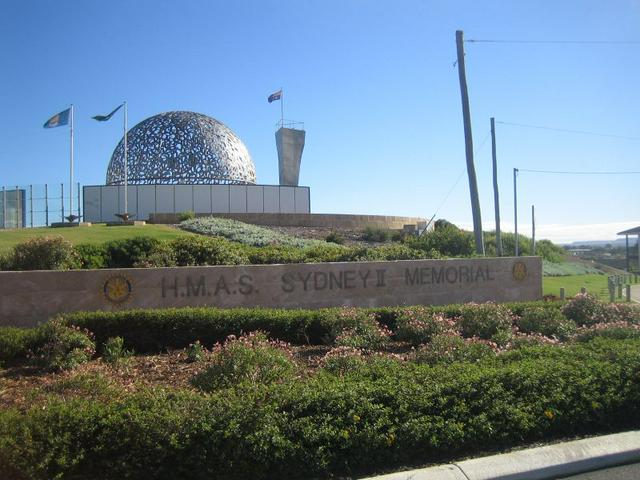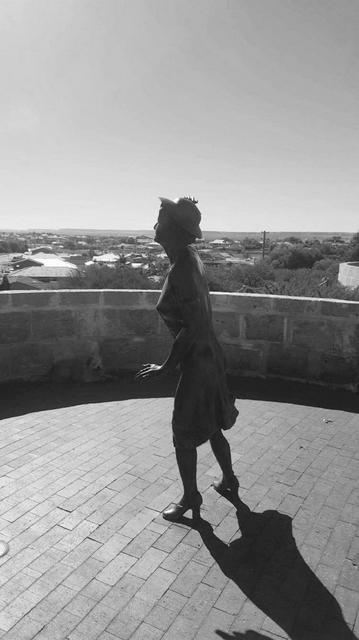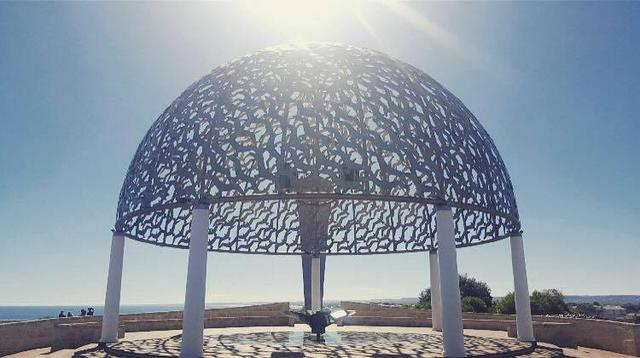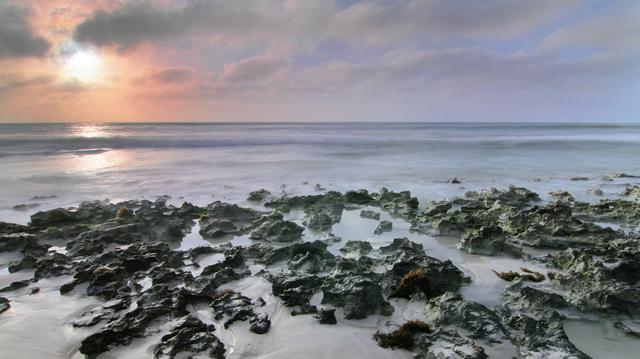The Geraldton Visitor Centre is located at 246 Marine Terrace, formerly the original Railway Station. The historic building is an icon in Geraldton's West End and was originally built in 1878. It was the first railway station constructed on a Government line in Western Australia. Now more than 140 years on, the building's heritage has been preserved through careful restoration and many elements from the original building feature in the Visitor Centre.
The Point Moore Lighthouse, located south of the Geraldton Port is a cultural and historical attraction. It is the oldest surviving Commonwealth lighthouse in Western Australia and was also the first steel tower to be constructed on the mainland of Australia. The Point Moore lighthouse stands 35m tall and its 1000w Tungsten Halogen Lamp can be seen for 23 nautical miles. It began operation in 1878. The tower was prefabricated in Birmingham, England in 1876 and reached Australia by boat in 1877. However, the foundation for the lighthouse was laid at the wrong place by the local contractors and had to be reconstructed at the new site. Currently, it is a heritage-listed structure which is visited by photographers, travellers, couples, artists, etc.
In 2007, the Geraldton foreshore area, previously an abandoned railway marshalling yard, was redeveloped and today hosts a playground with water activities, public green spaces, public beaches, picnic areas, basketball court and shaded play areas. The project was completed in 2008.
Geraldton is a regular port of call for cruise ships with visits occurring approximately ten times per year. Volunteers, organised by the City of Greater Geraldton, greet visitors on arrival to provide information on activities and other assistance.

 The memorial for the World War II cruiser is located on Gummer Avenue, at the summit of Mount Scott. The memorial recognises the loss of the light cruiser during a mutually destructive fight with the German auxiliary cruiser Kormoran off Shark Bay in November 1941, with none of the 645 crewmen aboard surviving. A temporary memorial, consisting of a large boulder, a flagpole, and a bronze plaque, was erected in 1998. A permanent memorial was dedicated on 18 November 2001, the day before the 60th anniversary. The HMAS Sydney memorial is made up of four major elements: 1. A stele, based on the ships prow; 2. A granite wall listing the ships company; 3. A bronze statue of a women looking out to sea and waiting in vain for Sydney to return; and 4. A dome made up of 645 stainless steel seagulls. The 645 Stainless steel seagulls represent the souls of the lost sailors. In Folklore, birds such as seagulls are sometimes known as 'soul birds' because they are regarded as the souls of people who died at sea. (Armstrong,1958) SydneyMcDonald, Seeking the Sydney, pp. 206-11
The memorial for the World War II cruiser is located on Gummer Avenue, at the summit of Mount Scott. The memorial recognises the loss of the light cruiser during a mutually destructive fight with the German auxiliary cruiser Kormoran off Shark Bay in November 1941, with none of the 645 crewmen aboard surviving. A temporary memorial, consisting of a large boulder, a flagpole, and a bronze plaque, was erected in 1998. A permanent memorial was dedicated on 18 November 2001, the day before the 60th anniversary. The HMAS Sydney memorial is made up of four major elements: 1. A stele, based on the ships prow; 2. A granite wall listing the ships company; 3. A bronze statue of a women looking out to sea and waiting in vain for Sydney to return; and 4. A dome made up of 645 stainless steel seagulls. The 645 Stainless steel seagulls represent the souls of the lost sailors. In Folklore, birds such as seagulls are sometimes known as 'soul birds' because they are regarded as the souls of people who died at sea. (Armstrong,1958) SydneyMcDonald, Seeking the Sydney, pp. 206-11
 In May 2009, the memorial was recognised by the Australian government as being of national significance.
In May 2009, the memorial was recognised by the Australian government as being of national significance.
Geraldton has a Mediterranean climate with dry, sunny conditions and warm sea temperatures throughout the summer. Mean sea temperatures in the summer months (measured at 10m) are consistently above 22C, often exceeding 24C. Surface sea temperatures in summer regularly exceed 26C.
The Geraldton foreshore area has pathways for walking, running, cycling, dog-walking, skateboarding and in-line skating. There are skate parks at Cape Burney, Maitland Park, Wonthella, Strathalbyn, Tarcoola Beach, Forrester and Drummond Cove.
Farmers markets occur on Saturday from 8 am to 12 noon in Maitland Park on Cathedral Avenue and on Sunday at the Old railway station on the corner of Chapman Road and Forrest Street.
4WD access is permitted on many beaches around Geraldton. Access points are usually labelled with information and cautions. Road rules apply and beaches are patrolled by local rangers. Non-compliance to road rules or entry into prohibited areas attracts significant penalties. Many beaches are impassable at times around high tide and during periods of ocean surges. At certain times of year, access may become impossible due to beach erosion.
During the spring, summer and early autumn months from September through April, Geraldton experiences consistent seabreezes. Windsurfing and kitesurfing locations include Back Beach, Separation Point ("Seppos"), Point Moore, Hell's Gate, St. George and Sunset Beach. The region is a popular windsurfing location, attracting significant numbers of overseas visitors and product testing by manufacturers. In 2005, Geraldton was host to the Australian KiteSurfing Association (AKSA) Australian National Championships.
Surfing, and more recently Stand-Up Paddlesurfing, are also popular activities in and around Geraldton. Popular surf spots include Flat Rocks, Headbutts, Greenough, Back Beach, Sunset Beach and Glenfield. Stand-Up Paddlesurfing spots include Point Moore, Town Beach, The Foreshore, St. Georges Beach and Drummond Cove to the north.
In winter, local weather conditions shift to predominantly easterly (offshore) winds. Indian Ocean storms generate large swells that produce good conditions for surfing (though the fringe barrier reef protecting the Geraldton coastline blocks much of the swell, significantly reducing the size of the waves that reach the beaches). Large swells may create potentially dangerous rip currents as water flows through passages between the reef.
Saltwater fishing, boating and sailing are popular along Geraldton's coastline.
Local and visiting recreational fishermen and women target a wide variety of native sport fish from the beaches and wharves that includes Mulloway, Bream, Tailor, Whiting, Sharks and Cod; larger fish such as Dhufish, Mackerel, Tuna, Snapper, Sampsonfish, Coral Trout and larger sharks, amongst many others are found on Geraldton's offshore reefs, located from approximately 8 km to more than 80 km offshore. A recreational fishing licence is not required when fishing from the shore but a licence must be obtained from the Department of Fisheries to fish from a boat. Significant fines apply for non-compliance. Recreational fishing for local Western Rock Lobster is also permitted during the season from December–April (exact dates vary from year to year) however, a special licence is required. Size and daily bag limits apply to certain species of fish and to all lobster catches.
The city is home to the Geraldton Yacht Club, which marked its 100th anniversary in 2014.
Scuba diving and snorkelling are popular activities around Geraldton. There are several wreck diving sites off the coast, including the South Tomi, which was sunk in 2004. The South Tomi is a 58.7 metre long, 9.81 metre wide vessel that was built by Niigata Engineering and Shipping Co Ltd. in Niigata City, Japan. In March 2001, the Republic of Togo registered South Tomi. The same month, the ship was identified fishing illegally in Australian sub-Antarctic waters and pursued by Australian Fisheries officers for 14 days, covering 3,300 nautical miles (approximately 6,100 kilometres). The vessel was boarded by Australian defence forces 320 nautical miles (approximately 600 km) south of Cape Town in South Africa and inspected. The vessel was found to be carrying an illegal catch of protected Patagonian toothfish and the vessel and its catch were confiscated by Australian authorities. The vessel was escorted 8,500 km to Western Australia and arrived on 5 May in Fremantle. The catch was sold by the Australian government for $1.4 million. The City of Geraldton secured the vessel to be sunk as an artificial reef. The ship was towed from Fremantle to Geraldton and scuttled on 18 September 2004 2.9 nautical miles off the Geraldton coast. The site is registered with the WA Department of Fisheries as a wreck and is closed year round to fishing within the defined boundaries – commencing at 28°43.968'S 114°33.392'E, then east to 114°33.206'E, then north to 28°43.752'S, then east to 114°33.392'E, then south to the commencement point. Water depth at the site is approximately 24.5 metres and the deck is 13 metres from the surface. The wreck of the South Tomi is one of WA's Top 10 Dive Wrecks and provides an easily accessible diving alternative to the nearby Houtman Abrolhos.
Geraldton has a number of resident sporting teams, including Australian Rules Football, Basketball, Netball, Soccer and Roller Derby League.
Geraldton is home to the Mid West Academy of Sport, a non-profit community organisation providing support to sporting talent (athletes, coaches, officials and administrators) throughout the Mid West Region of Western Australia.
Geraldton is home to a horse racing industry and since 1887 has hosted the annual Geraldton Gold Cup meeting.
The Geraldton Sunshine Festival, established in 1958, is one of Australia's longest-running festivals. The festival takes place annually in October, celebrating the arrival of Spring and providing opportunities for residents and visitors to engage with local businesses and other organisations.
The Goodness Sustainability and Innovation Festival is held each August in and around Geraldton and showcases and celebrates innovation and achievement towards sustainability in the Mid West.
The Big Sky Readers and Writers Festival - The festival has been hosted by the City Of Geraldton and run by The Geraldton Library staff. Australian and International authors come together to share their knowledge and experiences in many ways, from intimate dinners to large scale debates.
 The main beaches in Geraldton are Tarcoola Beach, Back Beach, Separation Point, Point Moore, Pages Beach, Town Beach, Champion Bay, St Georges, Sunset Beach and Bluff Point.
The main beaches in Geraldton are Tarcoola Beach, Back Beach, Separation Point, Point Moore, Pages Beach, Town Beach, Champion Bay, St Georges, Sunset Beach and Bluff Point.
The St Francis Xavier Cathedral was designed by World renowned Arts & Crafts architect and Catholic priest Monsignor John Hawes (1876 - 1956). Construction began in 1916 and was completed in 1938. The Cathedral's architecture is unique and considered one of the finest Cathedrals of the world built in the 20th Century.
The Anglican cathedral of Geraldton was built during the 1960s.
